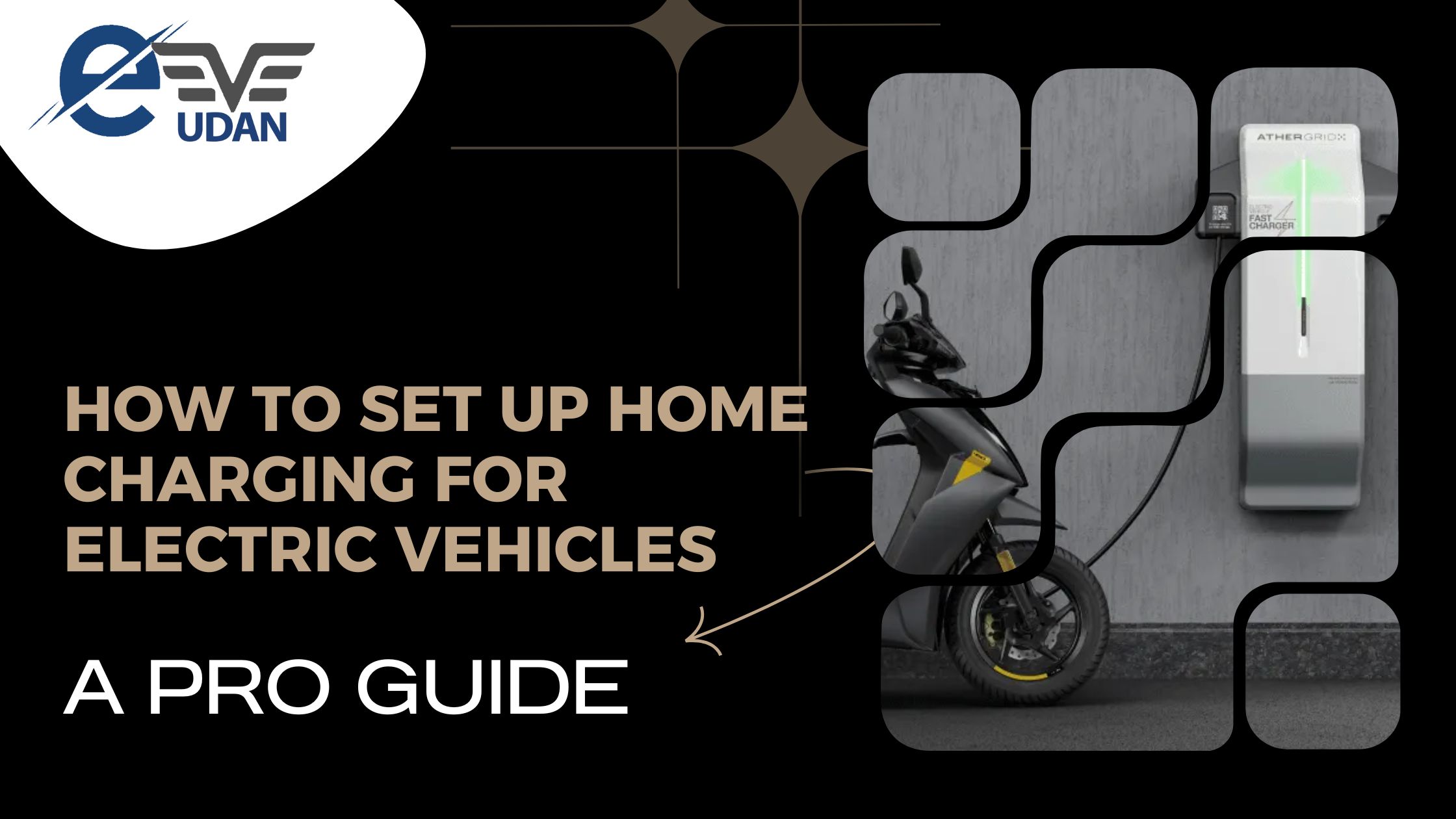- Your cart is empty
- Continue Shopping

How to Set Up Home Charging for Electric Vehicles: A Pro Guide
As more people choose electric vehicles, many owners want to install a home charging station. Charging for electric vehicles at home is convenient because you can easily plug in your car overnight or whenever it’s parked. This blog will guide you through installing an EV charger at home, the types of chargers available, and what you need for a safe and simple setup.
We cover everything you need to know, from Level 1 and Level 2 chargers to a step-by-step guide for installation. With proper planning, setting up your own home charger is straightforward. Home charging allows you to power your EV anytime you need. Just follow our guide or hire a professional to get started today. Let’s start by reading the blog and understanding the advantages of charging our EVs at home.
Why Should You Consider Home EV Charging?
Installing an EV charging station at home provides numerous benefits that enhance convenience and efficiency. These advantages not only improve your electric vehicle experience but also contribute to cost savings.
- Charge your vehicle overnight without visiting public stations.
- Lower electricity rates during off-peak hours can make home charging cheaper.
- Avoid waiting at public chargers; simply plug in and go about your day.
- Home charging stations can increase your property’s appeal to potential buyers.
- Choose the charger type that fits your needs, from Level 1 to Level 2.
- Use solar energy to charge your EV which helps to reduce your carbon footprint.
- Charge at home, alleviating worries about finding a charging station.
- Set charging times to benefit from lower rates and ensure your vehicle is ready when needed.
Once you are aware of the benefits of setting up an EV charging station at your home, you can move on to finding out the detailed instructions for repairing the charging configuration at your place.
A Pro Guide to Charging Electric Vehicles at Home
Charging for electric vehicles (EV) at home is a convenient and cost-effective way to ensure your vehicle is always ready to go. With the right setup, you can easily charge your EV overnight or during the day, depending on your schedule. In this section, we will walk you through a simple, step-by-step process to set up your home charging for an electric vehicle. This guide will give you the knowledge you need to get started, whether you are a new EV owner or just trying to maximize your charging experience. Let’s dive into the methods for setting up your EV charging station at home.
Step 1: Check & Upgrade Electrical Compatibility for EV Chargers
Most EV chargers require either a 120-volt or 240-volt connection. Consult an electrician to ensure your home is ready.
Before installing an EV home charger, check if your home electrical system can handle the extra load. Most homes support Level 1 chargers (120 volts) without any upgrades. However, for a faster Level 2 charger (240 volts), you need to make sure your panel has enough capacity.
Check the panel’s amp rating (usually found on the main breaker). A typical home may have a 100-amp or 200-amp panel. Installing a Level 2 charger usually requires an extra 30-50 amps, so if your panel is already close to its limit, you’ll need an upgrade. In case your house is not prepared, hire a certified electrician for:
- Inspect your electrical system.
- Upgrade your panel if needed.
- Install the necessary wiring for the charger.
The electrician will guide you through getting any required permits and ensure everything meets local regulations. This configuration enables the charging for electric vehicles to operate safely and effectively.
Step 2: Choose the Right Charger for Your Needs
Choosing the right EV charger depends on your daily driving habits, charging speed, and budget. There are three main types of EV chargers mentioned that are explained below:
- Level 1 Charger: you can use a standard 120-volt outlet. It’s slower but easy to install.
- Level 2 Charger: it requires a 240-volt connection and charges faster. This is ideal for regular EV users.
- DC Fast Charger: A DC Fast Charger quickly powers electric vehicles that offer 100-200 miles of range in 30 minutes.
If you drive short distances and have plenty of time to charge, a Level 1 charger is enough. It uses a standard outlet but charges slowly (3-5 miles per hour). It’s easy to install, with no special equipment needed.
For faster charging for electric vehicles, especially if you drive more or need quicker recharges, a Level 2 charger is better. It requires a 240-volt connection and charges 5-10 times faster (15-30 miles per hour). You’ll need an electrician for installation, but it’s worth it for regular EV use.
If you need to charge quickly on the go, especially during long trips, look for DC Fast Chargers at public stations. These can charge up to 80% of your battery in about 30 minutes. They’re not suitable for home use due to cost and high power demand.
Note: Overall, Level 1 is best for occasional charging, Level 2 for daily use, and DC Fast Chargers for quick top-ups while traveling.
Step 3: Selecting the Ideal Charging Location for Your EV Charger
Pick a spot near where you park your vehicle. Ensure the charger is close enough to reach the car’s charging port and that the area is safe from the elements. Here are some important points that you should keep in mind while choosing the perfect location for charging electric vehicles.
- Install the charger near where you park your car, so the charging cable easily reaches the car’s port.
- Choose a spot sheltered from rain, snow, and direct sunlight to protect the charger from damage.
- Ensure it’s easy to access, both for you and, if needed, for guests or service providers.
- Place it near your home’s electrical panel to reduce installation costs.
- Keep the area clear of clutter to avoid tripping hazards or damage to the charger.
Step 4: Hire a Professional Electrician
Hiring a professional electrician ensures a safe, reliable, and efficient EV charger installation, giving you peace of mind. Once you’ve chosen the charger, hire a certified electrician to install it. They will:
- Upgrade your electrical panel if needed.
- Run the necessary wiring.
- Install the charging unit safely and in compliance with local regulations.
Step 5: Get Permits (if required)
Before installing an EV charger, check if you need a permit. Some local governments require permits to ensure the installation meets safety and building codes. Contact your local building department or check their website to find out the specific requirements in your area. If a permit is needed, the electrician you hire can help you obtain it. They may need to submit plans and schedule inspections. Getting the right permits ensures that your installation is safe and compliant with local regulations.
Step 6: Install the Different Chargers
Here we are going to explain some main methods to explain how to install the chargers.
Phase 1: Level 1 Charger Installation
- Setup: A Level 1 charger uses a standard 120-volt outlet, making installation straightforward. Choose a convenient location near where you park your EV. Ensure the outlet is easily accessible and can support the charger, typically drawing 12-16 amps.
- Connection: Plug the charger into the outlet and connect it to your EV. Charging for electric vehicles starts automatically, and you can monitor the charging status on your vehicle’s dashboard. Level 1 chargers add about 4-5 miles of range per hour.
Phase 2: Level 2 Charger Installation
- Preparation: A Level 2 charger operates at 240 volts and charges your EV faster, adding 10-60 miles of range per hour. Choose a suitable spot for installation and hire a licensed electrician since it requires a dedicated circuit.
- Installation: The electrician will install a new circuit breaker, mount the charger securely on the wall, and connect it to the dedicated circuit. After testing for functionality and power flow, set up any smart features by connecting the charger to your home Wi-Fi.
Phase 3: DC Fast Charger Installation
- Planning: DC Fast Chargers are ideal for rapid charging, providing significant range in a short time (up to 80% in about 30 minutes). Choose a public or accessible location for installation and hire professionals experienced in high-voltage systems.
- Execution: Professionals will set up the necessary electrical infrastructure, securely mount the charger, and ensure all systems are functioning properly. Once installed, the charger will be ready for use, allowing EV drivers to quickly charge their vehicle.
Step 7: Testing, Setting Up, and Maintaining Your EV Charger
After the installation, the electrician will test the charger to check its function properly by checking the connections, power flow, and charging speed. If the charger has smart features, follow the instructions to connect it to your home Wi-Fi and set up options for scheduling and monitoring through a smartphone app. To charge electric vehicles, simply plug your EV into the charger and monitor the charging speed and time for optimal performance. Regular maintenance is important; check the charger for signs of wear or damage, and keep it clean and free of debris to ensure it operates efficiently.
Conclusion
Setting up an EV charging station at home is a smart and convenient way to ensure your electric vehicle is always charged and ready to go. By following this step-by-step guide, you can easily choose the right charger, understand your home’s electrical needs, and ensure a safe, efficient installation. Whether you hire a professional electrician or take a DIY approach, home charging gives you the freedom to power up your EV whenever it’s convenient. Ready to set up your own EV home charging station? Contact us today for expert advice or browse our range of reliable EV chargers to find the perfect fit for your home.
Frequently Asked Questions
Yes, you can install an EV charger at home. Many homeowners choose to install Level 1 or Level 2 chargers, depending on their needs and electrical capacity. For Level 2 chargers, it’s recommended to hire a professional electrician to ensure proper installation and safety.
Here are some simple steps to set up home EV charging:
1. Assess your home’s electrical system.
2. Choose the right charger (Level 1 or Level 2).
3. Hire a certified electrician for installation, especially for Level 2.
4. Follow the step-by-step installation process to ensure safety and efficiency.
